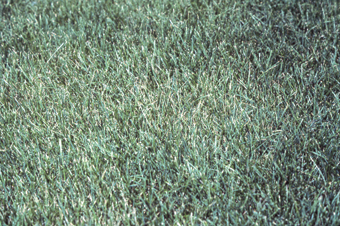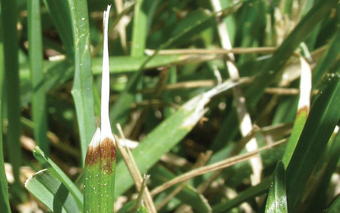G1917
Ascochyta Leaf Blight of Turf
Ascochyta leaf blight is most frequently found on Kentucky bluegrass. This NebGuide discusses the best ways to identify and manage it.
Loren J. Giesler, Extension Plant Pathologist
- Introduction
- Cause, Hosts, and Occurrence
- Key Symptoms
- Cultural/Maintenance Practices
- Fungicide Program
|
Introduction
Ascochyta leaf blight is a foliar disease most frequently found on Kentucky bluegrass. The disease also can occur on tall fescue and perennial ryegrass. Symptoms are typically irregular straw-colored patches in which the grass blades are killed from the tip down. This occurs through much of the growing season and is often associated with drought, but the conditions that trigger disease development are poorly understood. Adjusting cultural practices is the best way to manage this disease. The following information describes the disease and how to identify and manage it.
Cause, Hosts, and Occurrence
Cause: Ascochyta spp.
Primary hosts: Kentucky bluegrass, perennial ryegrass, and tall fescue
Occurrence: June-September
Key Symptoms
- Large areas of turf take on either a uniformly blighted appearance or a patchy appearance caused by localized areas of heavy infection (Figure 1).
- Individual leaves die from the tip back, often affecting the entire blade.
- Affected leaf blades often shrivel, forming a needle-point appearance from the tip down (Figure 2).
Note: The disease may appear severe and affect large areas of turf but seldom does permanent damage.
Cultural/Maintenance Practices
- Irrigate in the early morning hours.
- Manage thatch and promote water infiltration through soil aeration.
- Don’t allow the turf to go into drought/moisture stress during the growing season.
- Avoid excessive applications of nitrogen by using slow-release nitrogen fertilizers.
- Mow on a regular schedule and collect clippings when the disease is active.
Fungicide Program
Fungicides are not typically used to control Ascochyta leaf blight. Ascochyta leaf blight can be induced by plant stresses such as drought and low fertility. Usually, taking action to reduce stress in the turf will cause Ascochyta leaf blight symptoms to diminish.
This publication has been peer reviewed.
Visit the University of Nebraska–Lincoln Extension Publications Web site for more publications.
Index: Plant Diseases
Turf
Issued May 2011

